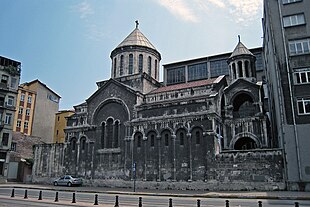| Saint Gregory the Illuminator Church | |
|---|---|
 The church in 2007 | |
| Religion | |
| Affiliation | Armenian Apostolic Church |
| Status | Active |
| Location | |
| Location | Kemeraltı, Sakızcılar Sok. No: 9, Karaköy, Istanbul, Turkey |
Location of the church in European Istanbul | |
| Geographic coordinates | 41°01′33″N 28°58′43″E / 41.0257°N 28.9785°E |
| Architecture | |
| Style | Armenian |
| Completed | 1391 (textual evidence) 1436 (oldest inscription) |
| Specifications | |
| Length | 29.25 metres (96.0 ft)[1] |
| Width | 11.7 metres (38 ft)[1] |
The Saint Gregory the Illuminator Church of Galata (Armenian: Ղալաթայի Սուրբ Գրիգոր Լուսաւորիչ եկեղեցի, Ghalat’ayi Surp Krikor Lusavorich yegeghetsi; Turkish: Surp Krikor Lusavoriç Ermeni Kilisesi) is the oldest extant Armenian Apostolic church in Istanbul. It was originally built in the late 14th century, in the Genoan period, shortly before the fall of Constantinople to the Ottomans. The church was demolished in 1958 and the current building is a reconstruction from the 1960s.
Located in the Galata neighbourhood, it is the city's only church built in the traditional style of Armenian church architecture—namely with a dome with a conical roof.[2][3] The Getronagan Armenian High School was established in 1886 next to the church.[4]
- ^ a b Cite error: The named reference
paroswas invoked but never defined (see the help page). - ^ Wharton, Alyson (2015). The Architects of Ottoman Constantinople: The Balyan Family and the History of Ottoman Architecture. I.B.Tauris. p. 63. ISBN 9781780768526.
The conical-domed structure was not seen in Constantinople except for the pre-Ottoman church of Surp Krikor Lusavoric of Karakoy.
- ^ Cite error: The named reference
patrikligiwas invoked but never defined (see the help page). - ^ Hacikyan, Agop Jack; Basmajian, Gabriel; Franchuk, Edward S.; Ouzounian, Nourhan (2005). The Heritage of Armenian Literature: From the eighteenth century to modern times. Detroit: Wayne State University Press. p. 17. ISBN 9780814332214.
